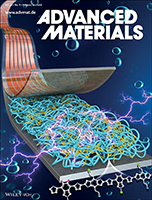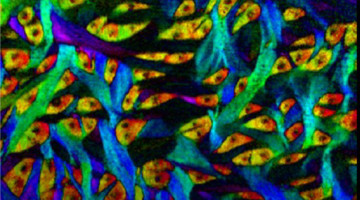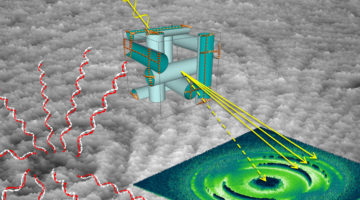Electronic vortex structures have been found to emerge from engineered samples of alternating complex-oxide layers. Resonant soft x-ray diffraction (RSXD) studies using circularly polarized x-rays revealed the vortices’ left- and right-handedness. The intriguing results open the door to electrically controllable chiral devices. Read more »
ALS Work Using Scattering/Diffraction
These techniques make use of the patterns of light produced when x-rays are deflected by the closely spaced lattice of atoms in solids and are commonly used to determine the structures of crystals and large molecules such as proteins.
Scientists Confirm Century-Old Speculation on the Chemistry of a High-Performance Battery
Scientists have discovered a novel chemical state of the element manganese. This chemical state, first proposed about 90 years ago, enables a high-performance, low-cost sodium-ion battery that could quickly and efficiently store and distribute energy produced by solar panels and wind turbines across the electrical grid. Read more »
Surpassing 10% Efficiency Benchmark for Nonfullerene Organic Solar Cells by Scalable Coating in Air from Single Nonhalogenated Solvent
Realizing over 10% efficiency in printed organic solar cells via scalable materials and less toxic solvents remains a grand challenge. In this article, Harald Ade and co‐workers report chlorine‐free, in‐air blade‐coating of a new photoactive combination, FTAZ:IT‐M, which is able to yield an efficiency of nearly 11%, despite a high humidity of ≈50%. Read more »
The Microstructure of a Parrotfish Tooth Contributes to Its Toughness
Parrotfish chew on coral, producing hundreds of pounds of sand each year. Mapping the microstructure of parrotfish teeth, scientists found bundles of crystals interwoven like chain mail. The results provide a blueprint for creating ultra-durable materials for mechanical components that undergo repetitive contact, movement, and abrasion. Read more »
Modified Antibody Clarifies Tumor-Killing Mechanisms
An antibody was modified to activate a specific pathway of the immune system, demonstrating its value in killing tumor cells. The work provides a platform for disentangling different immune-system pathways and could lead to the design of improved immunotherapies. Read more »![]()
![]()
X-Rays Reveal ‘Handedness’ in Swirling Electric Vortices
Scientists used spiraling x-rays at the ALS to observe, for the first time, a property that gives handedness to swirling electric patterns—dubbed polar vortices—in a synthetically layered material. Read more »
Enhancing the Efficiency of Organic Photovoltaics by a Photoactive Molecular Mediator
In the search for high-efficiency organic solar cells, additives often play an important role in improving the film morphology. Liquid additives, while often effective, evaporate or migrate over time. Herein, Liu et al. report a solid photoactive molecular mediator that could be employed to replace the liquid additives to tune the morphology of bulk heterojunction films for improved device performance. Read more »
X-Rays Provide Key Insights on Path to Lithium-Rich Battery Electrode
If you add more lithium to the positive electrode of a lithium-ion battery, it can store much more charge in the same amount of space, theoretically powering an electric car 30 to 50 percent farther between charges. But these lithium-rich cathodes quickly lose voltage, and years of research have not been able to pin down why—until now. Read more »
Revealing the Blue Phase and Other Twisted Orders
Resonant soft x-ray scattering revealed liquid crystal structures that cannot be probed using diffraction, including chiral liquid crystal systems such as the “blue phase” and the twist-bend nematic phase. Information on how individual molecules form functional structures in these systems is key to developing new applications. Read more »
X-Rays Reveal the Biting Truth About Parrotfish Teeth
A parrotfish’s hardy teeth allow it to chomp on coral all day long, ultimately grinding it up through digestion into fine sand. Researchers wanting to see how the fine crystal structure of parrotfish teeth contribute to their incredible strength were able to visualize the orientation of individual crystals, which showed their intricately woven structure. Read more »
- « Previous Page
- 1
- …
- 27
- 28
- 29
- 30
- 31
- …
- 39
- Next Page »









